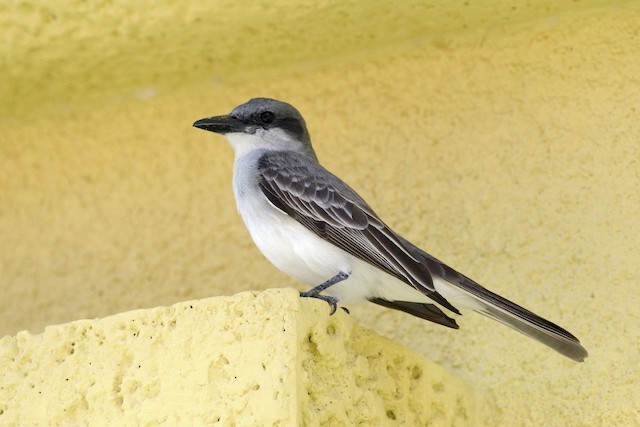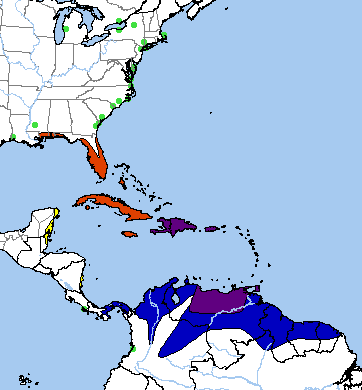Birdfinding.info ⇒ Common and conspicuous in lightly wooded and brushy habitats throughout the West Indies and much of Florida. Has a strong affinity for open coastal habitats, especially when breeding, but also occurs far inland and upland on all the large Caribbean islands and increasingly into the interior of South America. Highly tolerant of human activity and development: often perches on fences, powerlines, and buildings.
Gray Kingbird
Tyrannus dominicensis
Family: Tyrannidae
Breeds from the southeastern U.S. through the West Indies to Venezuela. Winters from Hispaniola to northern Brazil.
Breeding. Breeds throughout the West Indies, from Grand Bahama to Trinidad, islands of the southern Caribbean, and west to the Honduran Bay Islands and Belizean cayes. Also breeds in Florida, mainly near the coasts, west to Louisiana and north to Georgia. In South America, breeds in northern Colombia and Venezuela, south into the Llanos.
Nonbreeding. Winters mainly from Hispaniola east and south through the Lesser Antilles, and on the continent from central Panama east to French Guiana, and inland throughout the Llanos and Tepui region to the northernmost part of Brazil, in Roraima. Stragglers overwinter farther north in the breeding range.
Movements. Regular in migration along the Caribbean coast of Central America from Panama to the Yucatán Peninsula.
In spring, migrants regularly overshoot to coastal Texas and North Carolina, and occasionally inland to the Great Lakes. In fall, small numbers wander north along the Atlantic coast to the Carolinas, and occasionally as far as New England and Quebec.
Somewhat prone to long-distance vagrancy, with scattered records across North America, as far northwest as British Columbia (Cape Beal, Vancouver Island; September 29, 1889).
Identification
A large kingbird with white underparts, gray upperparts, a contrasting blackish mask, and a robust bill.
The wings are blackish with whitish margins. The tail shows a deep notch when relaxed.
In the West Indies, most likely to be confused with Loggerhead, Puerto Rican, Hispaniolan, and Giant Kingbirds, all distinguished by their dark caps. In the U.S., could be mistaken for Loggerhead Shrike.
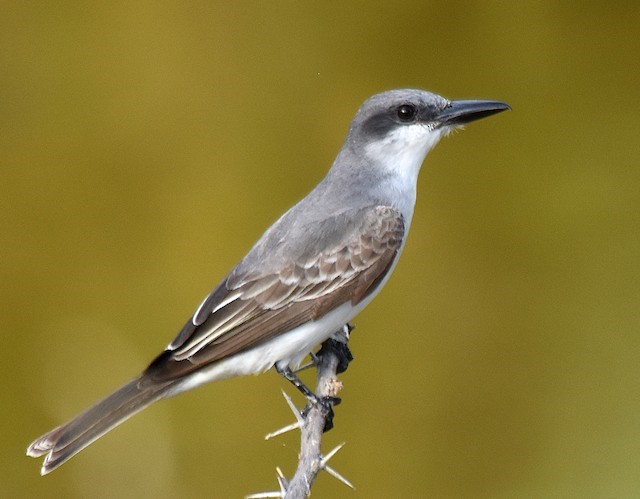
Gray Kingbird. (Great Salt Pond, St. Kitts; March 4, 2018.) © Steven Mlodinow

Gray Kingbird. (Christian Valley, Antigua; February 14, 2014.) © Stephen Gast
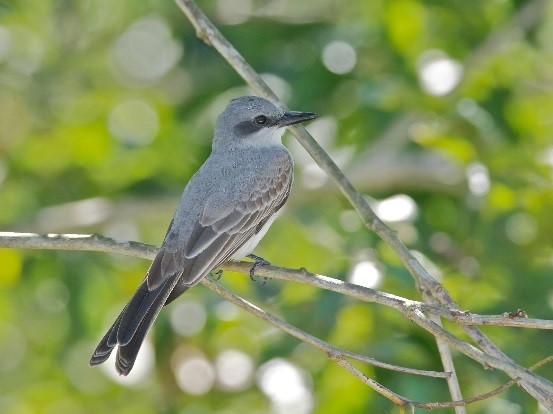
Gray Kingbird. (Laguna Cartagena National Wildlife Refuge, Puerto Rico; March 15, 2012.) © Paul A. Guris
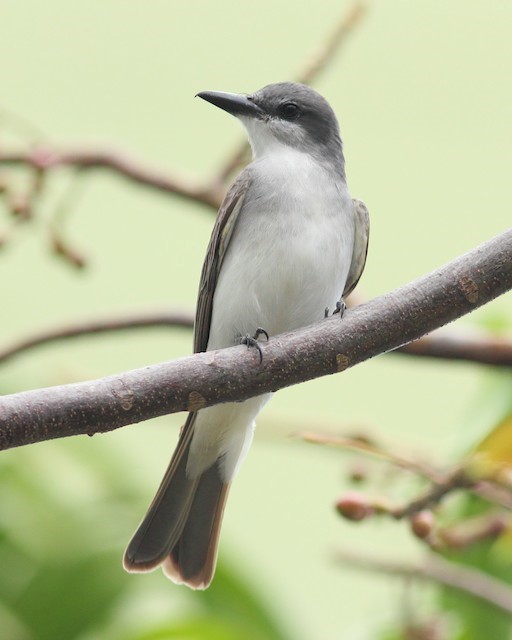
Gray Kingbird. (San Juan, Puerto Rico; March 18, 2012.) © Alan Selin

Gray Kingbird. (Christ Church, Barbados; March 25, 2018.) © Knut Hansen

Gray Kingbird. (Grand Anse, Grenada; April 4, 2012.) © Christophe Gouraud
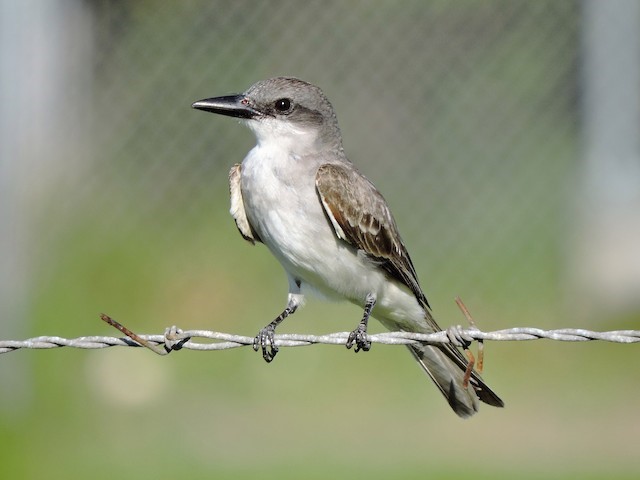
Gray Kingbird. (Port Canaveral, Florida; July 5, 2017.) © S. K. Jones
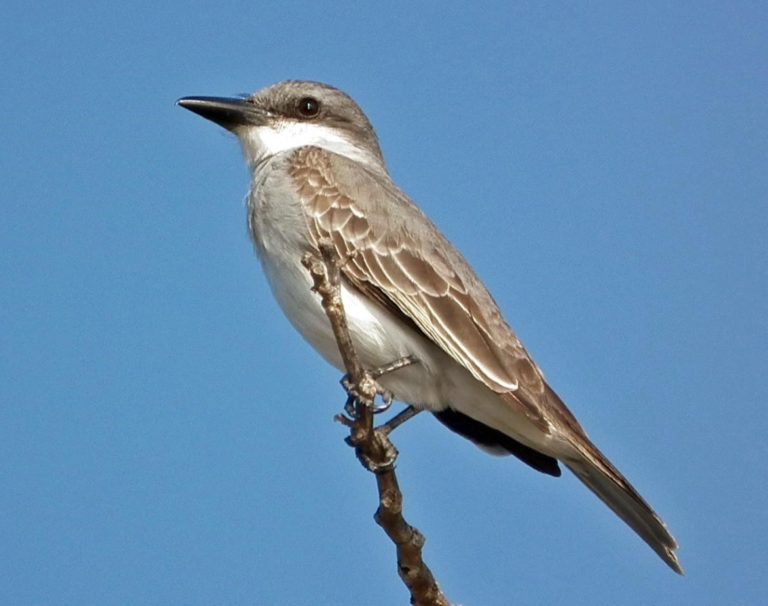
Gray Kingbird. (New Providence, Bahamas; May 8, 2011.) © Sam Shaw

Gray Kingbird. (Royal St. Kitts Golf Course, St. Kitts; March 5, 2018.) © Steven Mlodinow
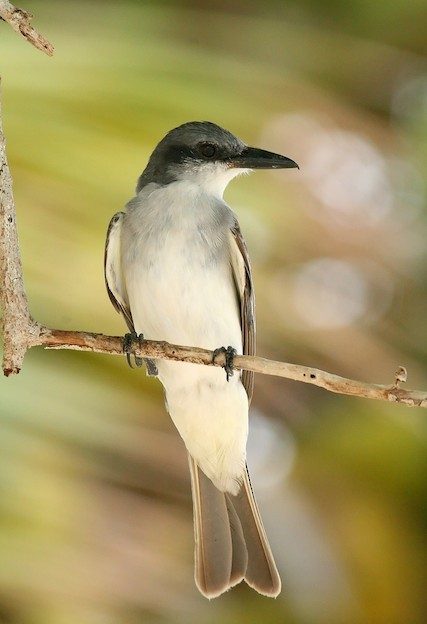
Gray Kingbird—note outsized bill. (Carambola Resort, St. Croix, U.S. Virgin Islands; June 6, 2008.) © Ryan Douglas
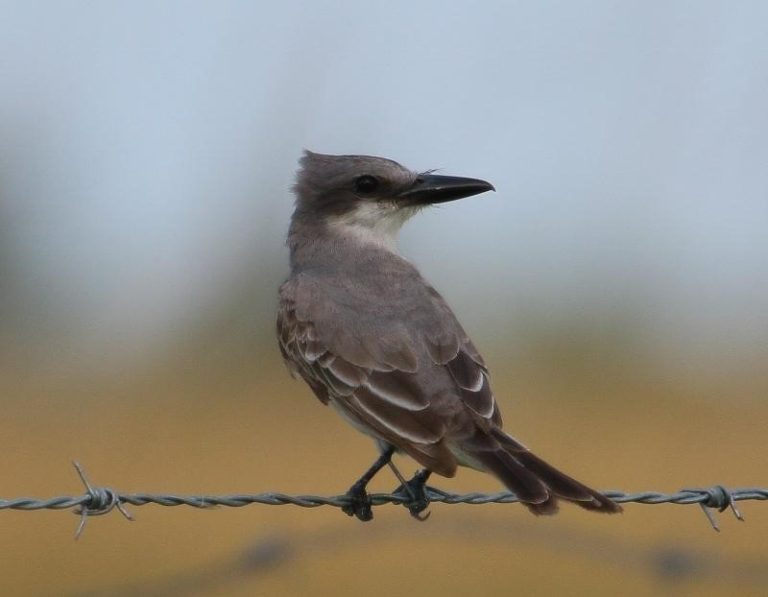
Gray Kingbird—note outsized bill. (Apure, Venezuela; July 29, 2015.) © Margareta Wieser
Immatures are similar to adults but browner above, especially on the wings, and with a yellow wash on the belly.
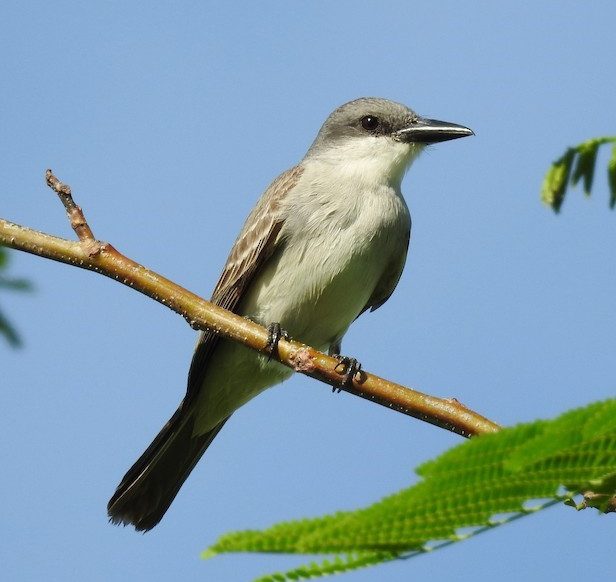
Gray Kingbird, immature. (Garden of the Gates, Freeport, Grand Bahama; June 2, 2018.) © Erika Gates
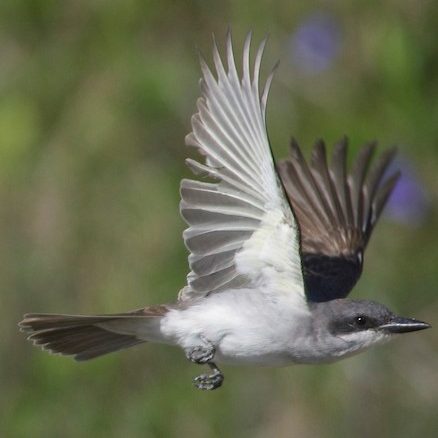
Gray Kingbird. (Fort Morgan State Historic Site, Alabama; May 4, 2016.) © Janice Nietzel
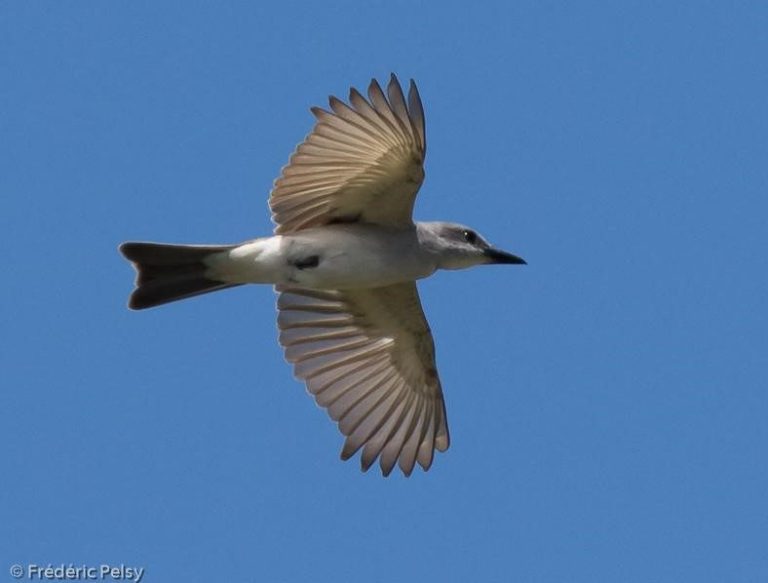
Gray Kingbird. (Santo Domingo, Dominican Republic; March 27, 2017.) © Frédéric Pelsy

Gray Kingbird, immature. (Mashes Sands County Park, Ochlockonee Bay, Florida; August 7, 2017.) © Andrew Cannizarro
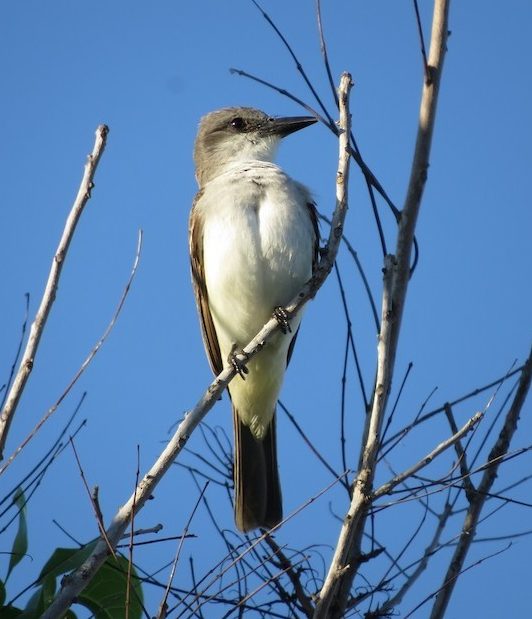
Gray Kingbird, immature. (Manasota Key, Florida; July 6, 2017.) © Margaret Dunson

Gray Kingbird, immature—note outsized bill. (Tobago; December 14, 2014.) © Charles J. Sharp
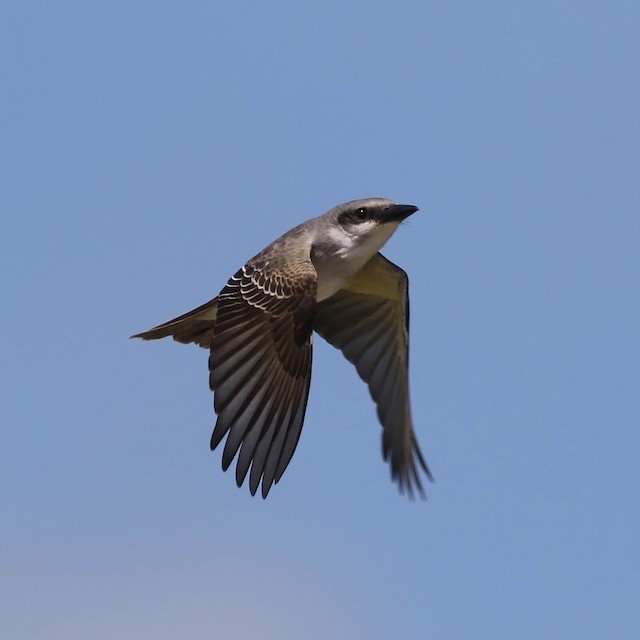
Gray Kingbird—note shrikelike appearance. (Curry Hammock State Park, Florida; September 16, 2018.) © Tony Leukering
Cf. Western Kingbird. Western is rare but regular throughout Gray’s U.S. range, particularly in autumn, and also has partly gray upperparts and a blackish mask. Adult Western differs from adult Gray in having a yellow belly and gray throat and breast.
The potential for confusion arises because the immature plumages converge toward one another. Immature Western is paler than the adult and may appear nearly white-bellied, while immature Gray is more colorful than the adult and often has a grayish breast and yellow wash on its belly. Bill sizes of the two species differ markedly: Western’s is much smaller than Gray’s.
Cf. Thick-billed Kingbird. Thick-billed has no range overlap with Gray, but both species sometimes stray long distances and sometimes turn up unexpectedly far beyond their usual ranges. Immature Thick-billed can show essentially the same plumage characters as immature Gray, so the thickness of the bill is the best distinguishing feature. (It seems more likely for a Gray, with its fairly heavy bill, to be optimistically misidentified as a Thick-billed than it does for a Thick-billed, with its massive bill, to be passed off as a Gray.)
Notes
Polytypic species consisting of two recognized subspecies, the widespread dominicensis and vorax of the Lesser Antilles.
References
Alderfer, J., and J.L. Dunn. 2014. National Geographic Complete Birds of North America (Second Edition). National Geographic Society, Washington, D.C.
Armistead, G.L., and M.J. Iliff, 2003. The Vagrancy of Gray Kingbird in North America. North American Birds 57:148-161.
Ascanio, D., G.A. Rodriguez, and R. Restall. 2017. Birds of Venezuela. Christopher Helm, London.
eBird. 2019. eBird: An online database of bird distribution and abundance. Cornell Lab of Ornithology, Ithaca, N.Y. http://www.ebird.org. (Accessed February 12, 2019.)
Fagan, J., and O. Komar. 2016. Peterson Field Guide to the Birds of Northern Central America. Houghton Mifflin Harcourt, New York.
ffrench, R. 2012. A Guide to the Birds of Trinidad & Tobago (Third Edition). Cornell University Press, Ithaca, N.Y.
Garrigues, R., and R. Dean. 2014. The Birds of Costa Rica: A Field Guide (Second Edition). Cornell University Press, Ithaca, N.Y.
Garrido, O.H, and A. Kirkconnell. 2000. Field Guide to the Birds of Cuba. Cornell University Press, Ithaca, N.Y.
Haynes-Sutton, A., A. Downer, R. Sutton, and Y.-J. Rey-Millet. 2009. A Photographic Guide to the Birds of Jamaica. Princeton University Press, Princeton, N.J.
Howell, S.N.G., and S. Webb. 1995. A Guide to the Birds of Mexico and Northern Central America. Oxford University Press, Oxford.
Latta, S., C. Rimmer, A. Keith, J. Wiley, H. Raffaele, K. McFarland, and E. Fernandez. 2006. Birds of the Dominican Republic and Haiti. Princeton University Press, Princeton, N.J.
McMullan, M., and T. Donegan. 2014, Field Guide to the Birds of Colombia (Second Edition). Fundación Proaves de Colombia, Bogotá.
Meyer de Schauensee, R., and W.H. Phelps, Jr. 1978. A Guide to the Birds of Venezuela. Princeton University Press, Princeton, N.J.
Raffaele, H. 1989. A Guide to the Birds of Puerto Rico and the Virgin Islands. Princeton University Press, Princeton, N.J.
Raffaele, H., J. Wiley, O. Garrido, A. Keith, and J. Raffaele. 1998. A Guide to the Birds of the West Indies. Princeton University Press, Princeton, N.J.
Ridgely, R.S., and G. Tudor. 2009. Field Guide to the Songbirds of South America: The Passerines. University of Texas Press, Austin.
Ridgely, R.S., and G. Tudor. 1994. The Birds of South America, Volume II: The Suboscine Passerines. University of Texas Press, Austin.
Wikiaves, Suiriri-cinza, http://www.wikiaves.com.br/suiriri-cinza
